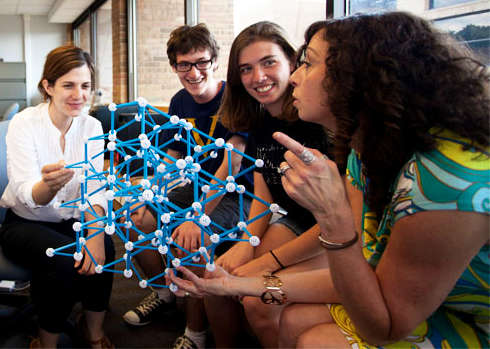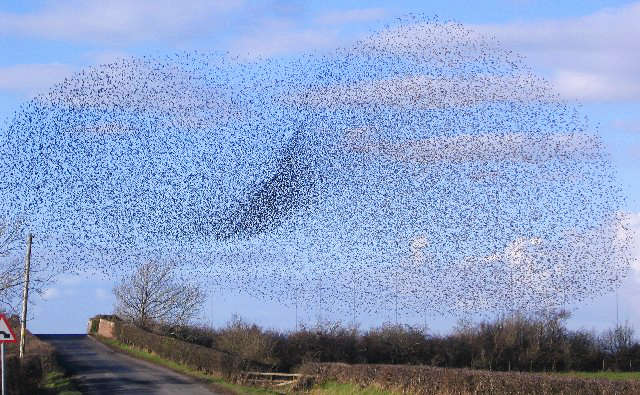By Doug Marman
Even the simplest organisms are amazingly complicated. This is why scientists who focus on the origin of life often study complexity. They try to find ways that intricate patterns can emerge from simple algorithms. They hope that this will give us clues on how cellular life evolved. This is a fallacy.
The mistake comes from confusing complexity, in general, with the specific kind of intricacies we find in living things. There is so much vague thinking about this subject that many scientists think that generating any kind of complexity can help solve the mystery of life. Countless hours have been wasted on this pursuit.
A recent article raises this issue again. “A ‘Digital Alchemist’ Unravels the Mysteries of Complexity” describes the fascinating work of Sharon Glotzer and her 33-person team, at the University of Michigan.
Glotzer uses computer simulations to study emergence — the phenomenon whereby simple objects give rise to surprising collective behaviors. “When flocks of starlings make these incredible patterns in the sky that look like they’re not even real, the way they’re changing constantly — people have been seeing those patterns since people were on the planet,” she said. “But only recently have scientists started to ask the question, how do they do that? How are the birds communicating so that it seems like they’re all following a blueprint?”[1]
Glotzer specializes in the way inert shapes can naturally align to create surprisingly complex patterns.
For example, if you have a room full of spheres, all the same size, they will naturally assemble into a simple lattice pattern. You only need to shake them gently and they will fall into this simple repeating pattern. What Glotzer discovered is that if you start with other shapes, such as pyramids, made from triangles on all sides, they produce quasi-crystalline patterns that never repeat. Simple shapes can produce surprisingly complex patterns.
Glotzer sees this as a potential new insight into the origin of life. She said:
Most scientists think that to have order you need chemical bonds — you need interactions. And we’ve shown that you don’t. You can just have objects that, if you just confine them enough, can self-organize… So it’s a completely different way to think about life and increasing complexity… I know because I’ve done this, that I can take a bunch of objects and put them in a little droplet and shrink the droplet a little, and these objects will spontaneously organize. So maybe that phenomenon is important in the origin of life, and I don’t think that’s been considered.
This insight about the patterns created by different shapes is valuable for the work that Glotzer does: creating new materials through molecular engineering. Unfortunately, it isn’t going to helps us solve the mystery of the origin of life because it displays the wrong kind of complexity.
This simple mistake happens far too often. It is time to kill this fallacy.
The reason that even smart scientists fall for this error is that they really don’t understand organic life. They can’t explain how even the simplest cells survive. Physics and chemistry don’t give us the tools needed to illuminate the secret of life.
What happens when we face something unknown, something we don’t understand? We naturally compare it to things that we know. That is why scientists keep trying to see if mechanical reactions can explain life.
Unfortunately, this doesn’t help, for a simple reason: Life is complicated in a special way that machines can’t achieve. Once you see this, you will realize why all of the games with computer algorithms, looking for ways to create complexity, are a waste of time.
To understand this, let’s start with one of the best introductions to this problem and how it relates to the origin of life. In Richard Dawkin’s book, “The Blind Watchmaker,” he asks:
So, what is a complex thing? How should we recognize it? In what sense is it true to say that a watch or an airliner or an earwig or a person is complex, but the moon is simple?[2]
Dawkins takes us down this path to show that we have to throw away many of the simplest ideas about complexity if we want to get at what really matters. For example, the moon is simple because it is one homogeneous thing, like a bowl of milk or the endless sands in the Sahara desert. Dawkins suggests that we need a system with many different elements. That is the kind of complication we are looking for.
However, this isn’t enough. A mountain, like Mont Blanc, is made up of many different types of rocks. And every area of Mont Blanc is truly unique and distinct from every other, making it far from simple. But this doesn’t resemble the patterns we find in organisms.
He then asks if we can get closer to the mystery of life by looking at probabilities. What if we say something is complex only if it has an arrangement of many different elements in a way that is highly improbable?
[I]f you take the parts of an airliner and jumble them up at random, the likelihood that you would happen to assemble a working Boeing is vanishingly small. There are billions of possible ways of putting together the bits of an airliner, and only one, or very few, of them would actually be an airliner. There are even more ways of putting together the scrambled parts of a human.
This approach to a definition of complexity is promising, but something more is still needed. There are billions of ways of throwing together the bits of Mont Blanc, it might be said, and only one of them is Mont Blanc. So what is it that makes the airliner and the human complicated, if Mont Blanc is simple?[3]
In other words, the complexity we are looking for can’t be found by just throwing things together. We need to see something more than just an accumulation of parts.
This shows why Glotzer’s discovery is not going to help. She researches the results of tossing things together. Yes, they can make amazing patterns that never repeat, which are fascinating, but it is still just a pile of parts. By itself, this pile doesn’t do anything special.
Therefore, it isn’t the improbability of a non-repeating pattern that we are looking for. We need something more. As Dawkins says:
If we see a plane in the air we can be sure that it was not assembled by randomly throwing scrap metal together…[4]
Intentional flight requires a different type of complexity. A plane allows people to travel around the world. That is what jumps out at us. Jets can’t be created by just throwing things together and hoping that something special is going to emerge.
But this is where I part ways with Richard Dawkins, because even this isn’t the kind of complexity we are looking for in living creatures. Why? Because planes are designed and constructed by human beings from a plan, from a blueprint. On the other hand, multicellular creatures, such as animals, fish, even trees and plants, develop from single cells, into complex bodies, made up of many organs that work intricately with each other. We don’t see the same thing in even the most sophisticated machines.
Can we explain the difference between the complexity of machines and organisms? Let’s look.
Planes don’t grow from seeds. That’s one difference. Here is another, plants and animals are not assembled by outsiders.
Airliners don’t seek for food or fuel on their own, while creatures are able to overcome incredible obstacles to find nutrition. Jets don’t develop unique ways of defending themselves from predators. And planes don’t reproduce by mating with other aircraft, or by dividing into two.
Organisms clearly show us a different kind of complexity than machines. Scientists keep trying to treat creatures as if they are sophisticated machines, but the metaphor fails in important ways. For example, biologists have been forced to abandon the old idea that DNA contains a blueprint for constructing the body of animals. It simply doesn’t work.
When DNA was first discovered, biologists expected to find one gene for every protein and enzyme needed in the human body. Once they mapped the whole genome, however, they found that there aren’t even close to enough genes to pull this off.
Every gene is involved in multiple roles. They also need to work with countless other genes. Many times, parts of one gene are used with parts from another, to get what is needed. And genes are turned on and off from outside the DNA.
Look at trees. They don’t follow a blueprint or a plan. That’s why the branches, leaves, and seeds emerge spontaneously at different places, making each tree unique. The blueprint idea simply doesn’t work as an explanation. This is one of the many failed attempts to compare living things to machines.
So we need to find a different kind of complexity than we see in machines. How do we describe this difference? Here is one way: You can’t take a creature apart to study how all of its organs and cells work together. If you try to do this, you will kill it.
That leads us to an even bigger difference: If a bird dies, it can no longer fly or search for food. Its body is just as complex as it was the moment before it died, but now it no longer hops on its feet, flaps its wings, or sings.
Robert Rosen’s description of complexity brings us closer to the mystery of life that we are searching for: A living organism is a system that cannot be fully explained by reducing it to its parts because it can only live when its parts work in a relationship with each other as a whole.
Rosen puts it this way:
It has turned out that, in order to be in a position to say what life is, we must spend a great deal of time in understanding what life is not. Thus, I will be spending a great deal of time with mechanisms and machines, ultimately to reject them, and replace them with something else. This is in fact the most radical step I shall take, because for the past three centuries, ideas of mechanism and machine have constituted the very essence of the adjective ‘scientific’; a rejection of them thus seems like a rejection of science itself.
But this turns out to be only a prejudice, and like all prejudices, it has disastrous consequences. In the present case, it makes the question ‘What is life?’ unanswerable; the initial presupposition that we are dealing with mechanism already excludes most of what we need to arrive at an answer. No amount of refinement or subtlety within the world of mechanism can avail; once we are in that world, what we need is already gone.[5]
This helps us see the enigma of life more clearly. This is the puzzle we need to solve. Now that we understand the mystery we are up against, it is easy to see why most discussions about complexity and the origin of life completely miss the point. Complex mechanisms and chemical reactions are not enough. Even random events won’t help because the puzzle we need to solve is to explain what makes living things alive.
No one has found a mixture of chemicals that alters its course, avoids threats, or replenishes itself. Chemical reactions simply stop when the energy driving them runs out. Then where does the remarkable desire for life come from?
A crystal, a candle flame, a hurricane, or a Bénard cell does not seek resources when the material conditions for continued catalysis runs out; they cease. Living things do so until all options are exhausted. Some of the simplest organisms engage in surprisingly elaborate behaviors to forestall cessation.[6]
How did a self-organizing, autocatalytic chemical system come to persist in such a way that it could be described as self-preserving…? We do not know. Moreover, we do not appear to be overly concerned that we do not know. The answer cannot be, it just did.[7]
One way to make this point even clearer is by distinguishing between “self-ordering” systems and the kind of organization that we see in living organisms, where cells and organs form responsive relationships, as they work with each other toward a common goal.
Self-ordering should not be confused with self-organization.[8]
A flame on a candle, the vortex that forms in tornados and hurricanes, and crystalline shapes are all examples of self-ordering. They are all the result of physical dynamics that can be explained with physics and chemistry.
No truly sophisticated function has ever arisen from self-ordered states.[9]
Living organizations are different. They require relationships between responsive life forms. For example, human beings work together for a common purpose. Cells and organs work together as a whole. And flocks of starlings fly together as a group. These types of living organizations can’t be explained by simple cause and effect mechanisms or principles of chemistry.
What Glotzer is talking about is clearly self-ordering, not self-organizing. Glotzer’s work is fascinating, but there is no great mystery in the way objects self-order and arrange themselves. This isn’t going to help us solve the enigma of life. Even a well-planned blueprint isn’t enough.
Living organizations and living organisms have a special form of complexity that can never be fully understood by taking them apart.
[1] Natalie Wolchover quotes Sharon Glotzer, “A ‘Digital Alchemist’ Unravels the Mysteries of Complexity,” Quanta Magazine, March 8, 2017.
[2] Richard Dawkins, The Blind Watchmaker (New York: W. W. Norton & Company, 1986), p. 6.
[3] Richard Dawkins, The Blind Watchmaker (New York: W. W. Norton & Company, 1986), p. 7.
[4] Richard Dawkins, The Blind Watchmaker (New York: W. W. Norton & Company, 1986), p. 8.
[5] Robert Rosen, Life Itself: A Comprehensive Inquiry into the Nature, Origin, and Fabrication of Life (New York: Columbia University Press, 1991), p. xv-xvi.
[6] Lyon, “To Be or Not To Be: Where Is Self-Preservation in Evolutionary Theory?” Major Transitions, p. 106.
[7] Ibid., p. 122.
[8] Abel DL, Trevors JT. Self-Organization vs. Self-Ordering events in life-origin models. Physics of Life Reviews. 2006;3, page 211. Also available from http://lifeorigin.academia.edu/DrDavidLAbel.
[9] Abel, DL. Life Origin, A Scientific Approach, edited for the non-scientist. Available from http://lifeorigin.info/whats-the-difference-between-self-ordering-and-self-organizing.html – _ENREF_21



